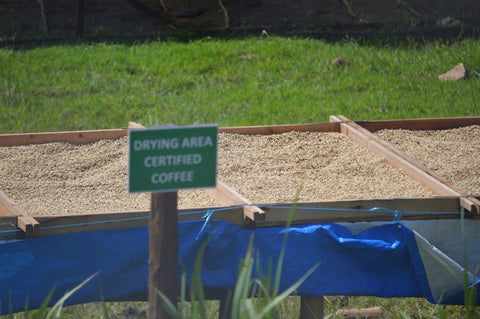Kyagalani Kapchorwa Washing Station
Kapchorwa, Uganda
Those of you who have been with us for a while know that we change up our coffees on a regular basis. While most coffee places tend to go with blends that have mass-market appeal, we love to showcase the vibrancy of the coffee and the potential that each farm can produce. Because of this, we switch throughout the year from coffee to coffee for our “House” coffee. And while we do change it around we tend not to go too extreme and stay with coffees that have classic coffee notes of nuts, chocolate and maybe a little berry.

Drying coffee at the Kapchorwa Washing Station, West Nile, Uganda. Photo courtesy of Volcafe.
Almost every year, I travel to Uganda to help the Uganda Coffee Development Authority with their annual Barista Championship. It’s been a rewarding time of helping the local coffee scene improve their coffeemaking techniques to get the full potential out of their coffees. Like most coffee producing nations, much of Uganda’s production is geared towards commercial coffee. Specialty coffee is still a small segment of their production but companies such as Volcafe and Great Lakes Coffee work with the local farmers across the country to help improve crop quality, better understand economics and, hopefully, deliver better quality coffees that yield greater prices to help feed their families and plan for their futures.
Our new “house” coffee is from the Kyagalanyi Kapchorwa Washing Station in eastern Uganda on the slopes of Mount Elgon, an extinct volcano with rich soil and great potential. Built in 2010, the Kapchorwa Washing Station serves 907 producers that are organized into 35 producer organizations. Our particular coffee comes from a smaller consortium of 45 farmers who, on average, own and operate farms that are about 1 hectare in size (about 2.5 acres). Each farm averages 978 coffee trees and coffee takes up from 75 to 90 percent of the farms’ area.
In order to ensure high quality coffee, farmers will deliver their ripe harvested cherries to the washing station where they are inspected. If 95 percent of the coffees are not of red ripe condition, the farmer will be sent to a separate area to sort out of the off-color, unripe cherries until the lot has been sorted properly.
Once approved the cherries run through the processing mill to remove its’ outer husk and then left for 12 hours overnight to ferment and remove the layer of mucilage covering the bean. In the morning, the coffee is floated in water to remove any additional materials and residue before being laid out to dry. A combination of sun drying and mechanical drying is employed at Kapchorwa until the coffee reaches to target moisture level of 12 percent. The coffee is then kept in dry storage until ready for export.
The Kapchorwa delivers a bright balanced acidity that is slightly muted by our roasting style. A round, heavy body also is a dominant character of this coffee that’s followed with notes of brown sugar, golden raisin and black pepper. On the nose, the coffee gives off aromas of peaches, oranges and honey. It’s really a great coffee and one that I think will be a great start to your day.
Kyagalani Kapchorwa Washing Station
Kapchorwa, Uganda
Elevation: 1700-2200 meters
Harvest Cycle: December 2016
Farmers: 45
Lot Separation: By farmer arrival
Varietals: Sl-14, SL-28, Bugisu Local
Washing Method: Fully Washed, 12 hour fermentation
Drying Method: Sun & Mechanical drying
Sourcing: Volcafe, UCDA
